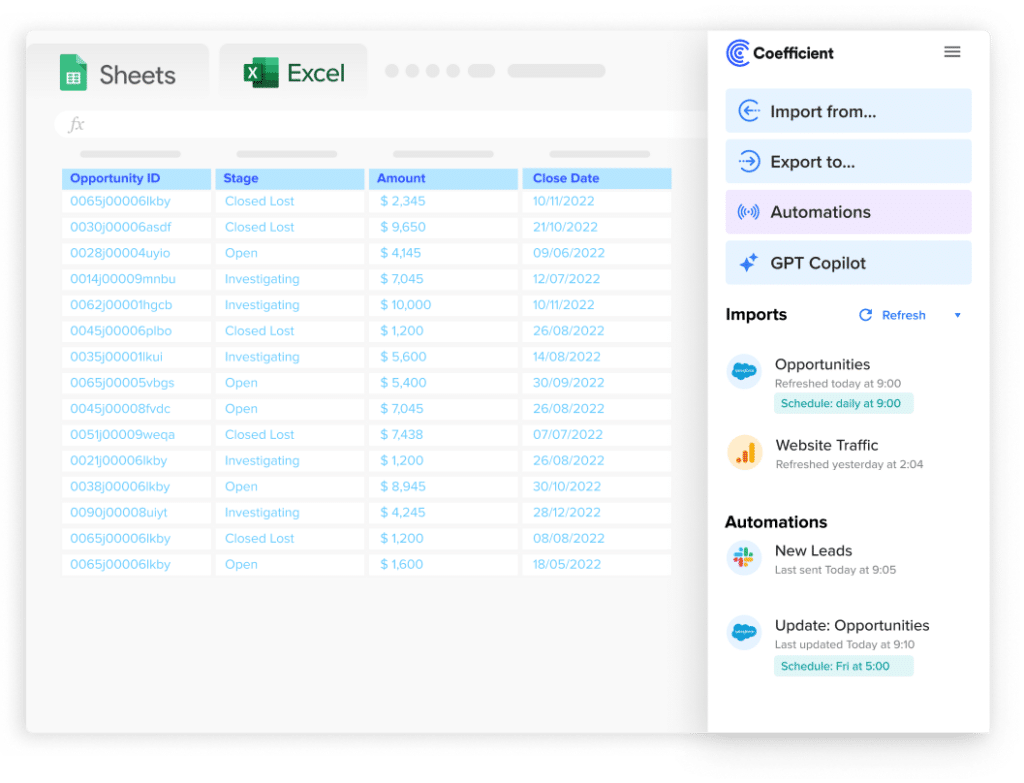AWS billing data helps teams track cloud spending. But raw billing data can be overwhelming.
By connecting AWS billing to Excel through Coefficient, you gain powerful analysis capabilities without leaving your spreadsheet environment.
Let’s walk through how to set it up!
Prefer video? Watch the tutorial here!
Advantages of using Excel to analyze AWS billing data
- See everything in one place. Consolidate all your AWS spending data in Excel, creating a central hub for cost monitoring across services, regions, and accounts.
- Unlock advanced analysis. Apply Excel’s robust formulas, pivot tables, and charting tools to identify spending patterns and optimization opportunities that might be missed in the AWS console.
- Create custom reports. Build tailored dashboards that highlight the metrics most relevant to your team, making it easier to communicate cloud costs to stakeholders.
Step-by-step tutorial: Connecting AWS billing to Excel
Before starting, ensure you have the Coefficient add-in installed in Excel. If not, download and install it from the Microsoft AppSource.
Step 1: Access Coefficient and select AWS billing
Open the Coefficient add-in. Launch Excel and click on the Coefficient icon in your ribbon to open the extension panel.

Select AWS billing as your data source. Click on “Import from” in the Coefficient panel, then search for and select “AWS billing” from the available data sources.

Stop exporting data manually. Sync data from your business systems into Google Sheets or Excel with Coefficient and set it on a refresh schedule.


Step 2: Authenticate with your AWS account
- Connect your AWS credentials. You’ll need to provide your AWS access key and secret key to establish the connection.
- Name your connection. Give your AWS connection a descriptive name to easily identify it for future use.

Step 3: Configure your data import
- Select metrics to import. By default, “Unblended Cost” is selected, but you can choose additional metrics like amortized cost, blended cost, or usage quantity.
- Choose your time granularity. Select between monthly, daily, or hourly views depending on how detailed you want your analysis to be.
- Set your grouping dimensions. By default, data is grouped by service, but you can add additional dimensions like availability zone, instance type, or billing entity.
- Import your data. Click the “Import” button to pull your configured AWS billing data into your Excel spreadsheet.

Step 4: Set up automatic refreshes
- Configure auto-refresh settings. Click on the Coefficient menu and select “Schedule Refresh” to keep your AWS billing data current.
- Choose your refresh frequency. Select how often you want your data to update—hourly, daily, or weekly—based on your reporting needs.

Take control of your cloud costs
AWS billing data becomes truly powerful when you can analyze it on your own terms. With Coefficient, you can pull live AWS spending information directly into Excel with just a few clicks. No more CSV exports or manual updates.
The direct connection ensures you’re always working with the most current data. Set up scheduled refreshes, and your reports will update automatically. Share insights with stakeholders knowing the numbers are accurate and up-to-date.
Ready to transform how you manage AWS costs? Get started with Coefficient today and bring your AWS billing data to life in Excel.

